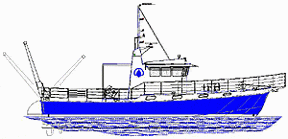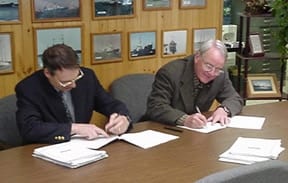WHOI and Massachusetts Firm Sign Contract to Build New Coastal Vessel
March 22, 2002
The Woods Hole Oceanographic Institution (WHOI) and Gladding-Hearn Shipbuilding, Duclos Corporation of Somerset, MA, signed a contract today to build a 60-foot vessel to replace the Institution’s aging 46-foot coastal vessel Asterias. Construction of the new vessel is estimated at a cost of $1.6 million, with delivery expected in March 2004.
“The need for this type of vessel has increased dramatically over the past few years as our interests in our continental shelf continue to increase,” said WHOI Director and President Robert Gagosian. “This vessel will provide quick and ready access to our new Martha’s Vineyard Observatory and surrounding waters, enhancing our continuing efforts in coastal oceanography.”
The Asterias replacement, designed by Roger Long Marine Architecture, Inc. of Cape Elizabeth, Maine, will offer researchers many expanded capabilities, including a cruising speed of 20 knots, providing efficient and quick access to coastal waters including Martha’s Vineyard and Nantucket Sounds and Massachusetts Bay. It can operate within a narrow weather window, as little as four hours, for distances up to 350 miles, which would enable it to reach New York harbor and the Gulf of Maine, where a number of Institution staff are conducting research or are interested in pursuing research projects. It is intended for use inshore, not offshore. The new vessel, whose name will be determined at a later date, will have a single operator for day trips and can accommodate six people for overnight trips or up to 10 people for day trips. At $1,500 a day, its day rate is very competitive, making it a cost effective platform for instrument testing, coastal studies and educational programs.
“The increased use of autonomous instruments and vehicles, our new observatory on the south coast of Martha’s Vineyard, and an increased focus on coastal processes are among the many reasons we need a more capable vessel to meet changing science needs,” said Wayne “Rocky” Geyer, chair of the Applied Ocean Physics and Engineering Department and a physical oceanographer who works in the coastal environment. “This new vessel will enable us to enhance our seagoing educational experience, bringing WHOI’s tradition of leadership in marine operations into the near-shore environment. That experience has been limited somewhat by the realities of long cruises on our larger research vessels, which are generally 30 to 40 days in length. Opportunities for students to conduct research on a variety of coastal processes will now be within a day’s reach with this vessel.”
According to Ernest “Dutch” Wegman, WHOI¹s Port Engineer and Project Manager for this vessel, the Asterias replacement will provide high quality diver support including a dive platform, dive locker and shower. It will be able to handle complex instrument arrays and coastal moorings through a 10,000 lb. stern A-frame, and its versatile fantail and booms will enable scientists and engineers to tow new instrument systems. Among the standard instrumentation planned for the vessel are a flow-through water sampling system, a full suite of meteorological measurement systems (IMET), an acoustic doppler current profiler (ADCP) and conductivity/temperature/density (CTD) with winch for a variety of physical oceanographic measurements, and clean power.
“Scientists and engineers are pursing more complex problems and using increasingly sophisticated equipment they often design, build and need to test,” Wegman said. “Their sea-going needs have changed considerably in the past decade as technology has advanced, and it became clear the Institution needed a new generation of near-shore vessel for a new generation of measurement systems which require nimble, quick response, but also considerable muscle for deploying complex arrays.”
The 46-foot Asterias was built in 1980 and replaced a similar 40-foot vessel of the same name which had served the Institution since its founding in 1930. The original Asterias was the Institution’s first research vessel. Asterias will be retired from the Institution fleet when the new vessel arrives, but will continue to serve science, engineering and educational needs until that time.
Asterias is reaching the end of its useful life for current science and engineering projects in local waters,” notes Vice President for Marine Operations Richard Pittenger. “The design for the new vessel reflects the increasing interest and research activity in coastal research at the Institution. Asterias has been a good vessel, but it is clear changing research needs and societal questions our staff seek to address require a much more capable vessel. This new vessel will provide researchers with a new generation of near-shore vessel with tremendous capabilities for many years to come.
Gladding-Hearn Shipbuilding has built more than 330 high quality commercial vessels since 1955 and is renowned for its ability to design and build unique and specialized craft such as fast ferries, police and fire boats, pilot boats, tug boats, fishing boats, research vessels and other distinctive vessels. The shipyard currently has 13 vessels under contract and has built research vessels for the University of New Hampshire and Old Dominion University.
Vessel Design Specifications:
Length: 60 feet
Beam: 17 feet
Draft: 5 feet
Range: 350 miles
Cruising speed: 20 knots (22.5 max)
Endurance: usually one day, occasionally 2 to 3 days
Accommodations: 6 bunks (10 people on day trips)
Gear Handling: A-frame: 10,000 pounds
Fantail : 15 by 20 feet
Special Capabilities: Dive support, ADCP, CTD, clean power


